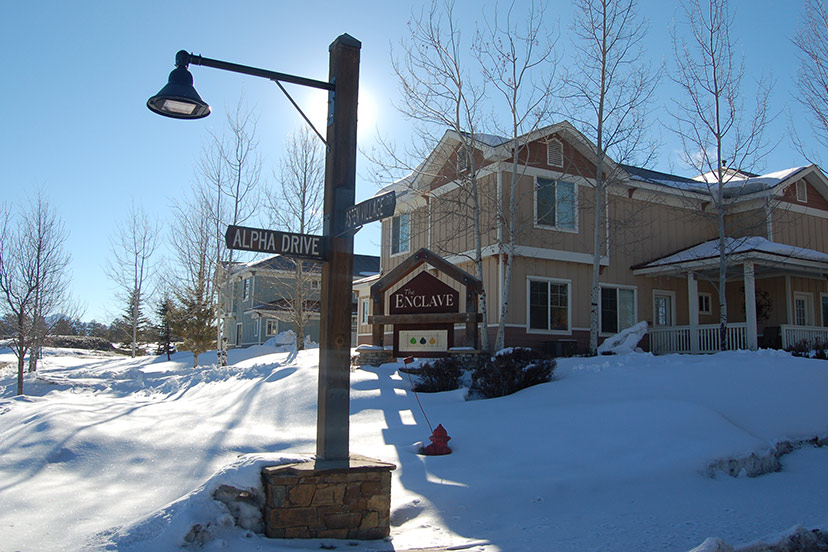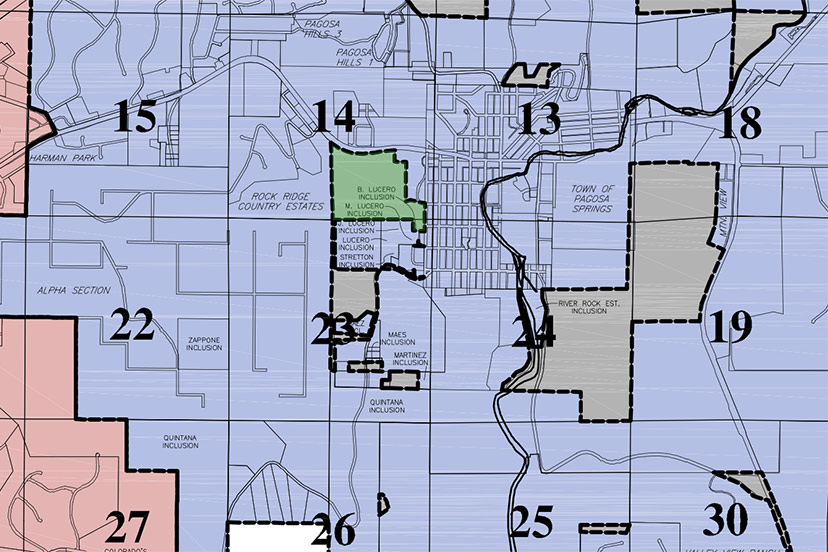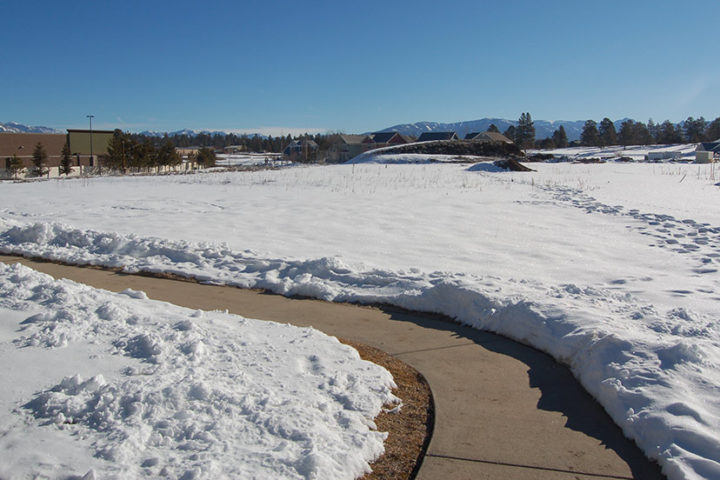As was mentioned in Part One, the Pagosa Springs Area Water and Sanitation District (PAWSD) board will meet tonight at 5pm to consider the proposed ‘Pagosa Views’ subdivision, a mixed-use project — homes, apartments, condos, recreation facilities, lodging, and commercial businesses — on an 80-acre parcel immediately west of the Pagosa Springs Elementary School.
This is the Zoom link for that meeting: https://us02web.zoom.us/j/85972804524?pwd=aThBaHRiNzJZeWZuai9FdUQyVXovQT09
The PAWSD board was supposed to consider a ‘Will Serve’ letter at tonight’s meeting… but the developers apparently changed their minds and, yesterday, asked to have the board consider, instead, ‘inclusion’ of the property into the PAWSD district.
Which makes sense, because the property is not currently within the PAWSD district, even though it’s almost completely surround by the PAWSD district, shown in blue or pink. I’ve colored the Pagosa Views parcel in green. (Other parcels not included in the PAWSD district are shown in gray.)
Unfortunately, the PAWSD board does not yet have modeling data on which to make an inclusion decision.
Disclosure: I currently serve on the Pagosa Area Water and Sanitation District (PAWSD) board of directors, but this editorial reflects only my own personal opinions, and not necessarily those the PAWSD board as a whole.
‘Pagosa Views’ would nearly double the number of residences served by the Town’s sewer district.
At their June 21 regular meeting, the seven-member Pagosa Springs Town Council — Mayor Shari Pierce, and Council members Maddie Bergon, Mat deGraaf, Matt DeGuise, Brooks Lindner, Gary Williams and Jeff Posey — questioned the developers about their plans, and then unanimously approved a ‘Sketch Plan’ with certain stipulations.
The developers have promised a significant number of small, affordably priced dwellings — with rents ranging from from $590 up to $1,850 a month and ‘for sale’ prices starting at $159,000 to $179,000 — and also a some larger homes, in the $480,000 to $630,000 price range.
The ‘Sketch Plan’ approval is merely a preliminary step in a longer approval process. The property is currently within the municipal boundaries, but the proposed development plan will require a zoning change, and other approvals.
The second action at Thursday’s meeting, also related to the housing crisis, was a decision to purchase 3.5 acres of vacant land immediately south of the Walmart store, and immediately east of the Enclave town homes.
I took a photo of that parcel last winter. Centrally located. Flat and buildable.
The Council agreed to pay $550,000 for the parcel, which already has some residential infrastructure installed.
It’s a parcel that’s been crying out to become a site for homes for quite some time now. Since about 2007. 15 years.
Although the Council didn’t specifically say so during the Thursday meeting, my assumption is that the parcel will be leased to Texas-based Servitas, as a site for some of the apartment units that had been previously designed for less-than-one-acre in the midst of South Pagosa Park. When the neighborhood objected to a public park being converted into a workforce housing site, the Town staff began looking for vacant parcels to be purchased and subsequently provided to Servitas, to help make Servitas’ workforce housing development ‘pencil’.
3.5 acres ought to do the trick?
Following the Great Recession — in 2017 — potential developers of this same “Enclave” parcel approached the Town asking to have the zoning changed, from medium density R-12 (maximum 12 dwelling units per acre) to high density R-22 (maximum 22 dwelling units per acre.) Back then, the Town had a rather different philosophy about what kinds of housing were appropriate for Pagosa Springs.
At the hearing in 2017, developer Emil Wanatka of Durango represented Aspen Village Ventures LLC… the partnership that began building out “The Enclave” townhomes back in 2007, and then stopped after completing only 10 of the 48 units approved for that development.
Mr. Wanatka’s Powerpoint presentation was thorough and detailed, and included a few photos of housing projects he has completed in Durango. He was hoping for a zoning change to allow higher residential density on the three acres.
Town staff had brought forth a proposed ordinance that aligned with a recommendation from the Town Planning Commission, approving the requested density increase but prohibiting the construction of apartments within the three acres.
Basically, the Council was deciding between two approaches to Pagosa’s future.
1. Keep Pagosa Pagosa
…or…
2. Keep Pagosa Pagosa
As an amateur student of Pagosa history, I have the impression that “government planning” had very little to do with how our little rural town assembled itself between 1883 and 1990. Generally speaking, individuals who bought property along the main highway built commercial buildings, and individuals who bought property back from the main highway built residential homes.
The buildings were built in the style of the day, and it’s pretty obvious that Pagosa Springs built out slowly, over many decades — unlike many of the mining towns in Colorado that sprang up in a matter of months during the hasty development of nearby mining operations. A walk along any downtown Pagosa street reveals architecture from most every decade between about 1920 and 2020.
It wasn’t until about 1990 — and more actively, beginning in about 2000 — that the municipal government took on the role of Centralized Designer of the Community. Various planning professionals were hired, as consultants or on salary, to help create laws and regulations, purportedly to make Pagosa Springs a “better” place to live.
But the planners were also supposed to preserve the “small town character” of the town.
Curiously enough, the people of Pagosa Springs — many of them, without even a high school education — had created that very “small town character” without much help from government planners.
But, somehow, the Town government had lost faith in the people of Pagosa, and determined that the only way to keep the community from changing too much, while also forcing it to change in the ‘right’ direction, was to spend tens of thousands of tax dollars on professional planners with college degrees. (Or, in some cases, on professional planners without much experience at all.)
Only four of the seven members of the Council were present to vote on the Enclave proposal, in March 2017: Mayor Don Volger, Tracy Bunning, David Schanzenbaker and Nicole DeMarco. The choice before them was challenging.
1. Keep Pagosa Pagosa, by denying the Aspen Village Ventures’ application for the density increase. Developer Emil Wanatka suggested, during his presentation, that denial of the application would likely discourage residential development from taking place at the site. He carefully explained that market forces, combined with the high cost of construction in remote rural communities like Pagosa Springs, make it impossible to sell the style of homes his company had envisioned back in 2005.
Town Council had the option of denying the density increase, and of “keeping Pagosa Pagosa.” Which is to say, keep Pagosa undeveloped and suffering from a shortage of workforce housing.
2. Keep Pagosa Pagosa, by allowing entrepreneurial individuals relatively free reign to build the types of homes they believe will suit the community’s needs, while providing a paycheck to the carpenters and a profit to the company. This approach would place minimal restraints on the developer, with the assumption that he (or she) will, sensibly, build homes that are attractive enough to be saleable on the open market — or that will feature rents cheap enough to serve Pagosa’s population.
Sort of the way Pagosa used to be, before “planning professionals” took over the government. Before our governments decided to become Centralized Designers of the Community.
Mr. Wanatka did his best to sell the idea that Pagosa desperately needs more, and more affordable, rental apartments to serve our working class families and individuals.
But the density-increase ordinance written by Town staff specifically prohibited apartments.
The Council could have changed the ordinance. But in the end, the Council voted to keep Pagosa Pagosa, by approving the staff-written ordinance and prohibiting apartments. Only then-Mayor Don Volger voted against the ordinance as written.
Five years later, the Town Council approved the first reading of an ordinance to spend $550,000 in taxpayer revenues… to help facilitate precisely the type of development a previous Council had forbidden Aspen Village Ventures from doing in 2017.



